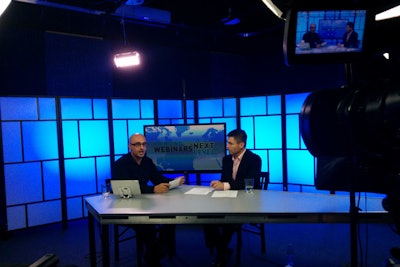
The practice of live-streaming events has become popular as technology has improved, costs have come down, and planners tap into the opportunity to reach a much bigger audience. But when does it make sense to produce an event solely for online participation, without anyone experiencing it in person? Kevin Larstone is the executive producer and creative director for Create If, an event production company that predominantly works with corporate clients throughout Canada. “There’s always value in doing a live meeting, but the return on investment is something that can only be measured by how deep a client’s pockets are. If you are plotting your course based on what your audience needs, that will tell you whether you should do a live presentation or a virtual presentation," he says. "With either one, the outcome you are looking for is some level of engagement. Just passively providing a feed to an audience without engaging them is a waste of money."
Larstone has worked with Matthew Ley, president of the Streaming Network, to produce several meetings for audiences that are entirely online. Here are their suggestions for when a virtual meeting may be the appropriate strategy and tips on how to execute it effectively.
Consider a fully virtual meeting when:
The in-person audience would be small. If the number of people attending your event in person would be much less than those tuning in online, consider eliminating the face-to-face event. “Does it make sense to stage this and build this for this physical audience just because that’s what you’ve always done,” Ley asks, "or should you take it completely online and build the entire event plus interactions within the event based on the desktop or tablet viewer?"
Cost is an issue. Hosting a physical event comes with a variety of potential costs, such as room rental, decor, food, and transportation. When planning an event that has both in-person and online components, Ley says often clients will allocate the majority of their budget to the physical event and skimp on production for the virtual audience, even though that is likely a larger number of people. By eliminating the physical event, resources can focus on creating a high-quality online experience.
There are logistical issues. For a client who needed to educate 350 sales people located across Canada about new products and marketing tools, Larstone considered training a team of executives to travel to cities around the country and share the same PowerPoint presentation. But he was concerned about consistency, so instead he created a virtual meeting that was repeated throughout the day to reach people in each time zone. “We shared audio and video through a Web browser and telephone access. So the sales people could experience it from wherever they were, even parked on the side of the road if they needed to,” he says.
To produce an effective virtual event:
Model it on TV programs. “If you have a panel discussion, one camera on four speakers is not a very dynamic look and feel. You’re not going to be able to capture the essence of the conversation like people are used to seeing when they watch CNN or Meet the Press on Sunday mornings,” Ley says.
Prep your speakers. Engaging an online audience requires presenters to use different strategies than engaging a live audience. For example, walking around is less important if the audience is strictly online, but audience interaction is critical. “You want to get them participating sooner than you might in a physical room where you know you have all the heads facing forward and you’re able to get that 30 minutes of presentation out of the way before you get into Q&A,” Ley says.
Structure content in segments. Don’t expect to hold the attention of online participants for more than about 20 minutes at a time. Larstone suggests interspersing quizzes, games, and other interactive components in between blocks of content. “We like to keep it very simple and even humorous, with sound effects and things like that to create that engagement,” he says.
Incorporate visuals. Slides, videos, and set changes serve to hold your audience’s attention.
Create a recording. Once planners have secured cameras and other equipment for a virtual event, it’s easy to record it and make it available on-demand. Ley suggests dividing it into segments based on topic.“Otherwise people will skim like they skim read and they may not get your message,” he says. "You want to provide a way for people to grab the content they want when they are viewing in an on-demand setting."


















